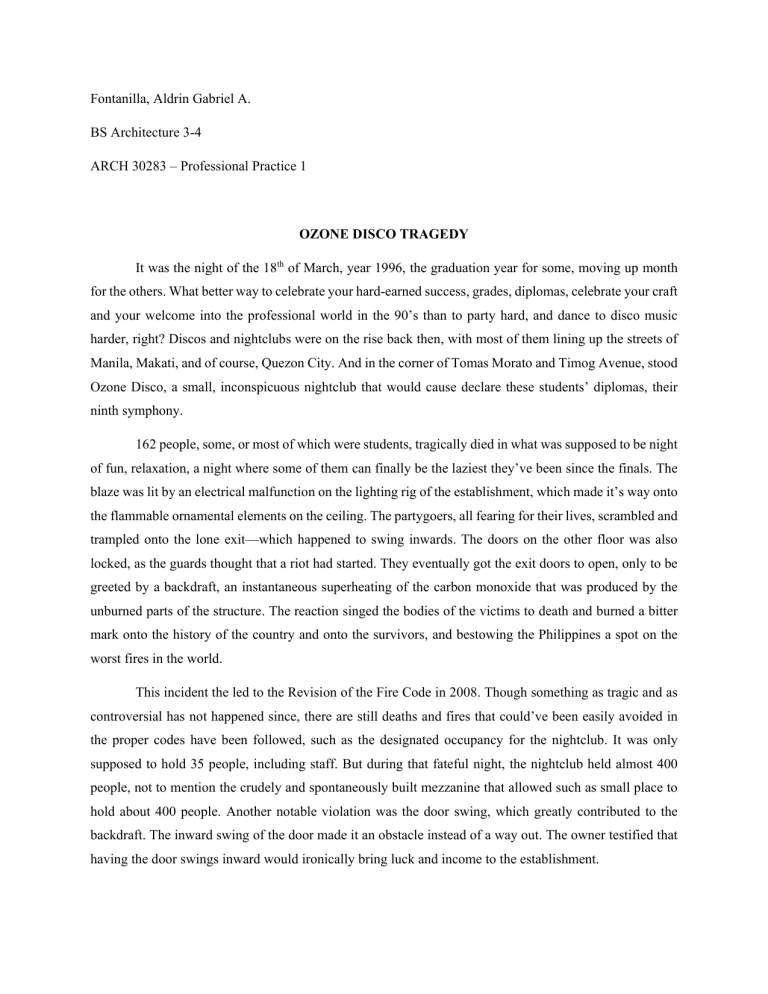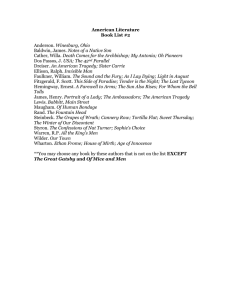Essay for Professional Practice 1: Ozone Disco Tragedy - Aldrin Fontanilla
advertisement

Fontanilla, Aldrin Gabriel A. BS Architecture 3-4 ARCH 30283 – Professional Practice 1 OZONE DISCO TRAGEDY It was the night of the 18th of March, year 1996, the graduation year for some, moving up month for the others. What better way to celebrate your hard-earned success, grades, diplomas, celebrate your craft and your welcome into the professional world in the 90’s than to party hard, and dance to disco music harder, right? Discos and nightclubs were on the rise back then, with most of them lining up the streets of Manila, Makati, and of course, Quezon City. And in the corner of Tomas Morato and Timog Avenue, stood Ozone Disco, a small, inconspicuous nightclub that would cause declare these students’ diplomas, their ninth symphony. 162 people, some, or most of which were students, tragically died in what was supposed to be night of fun, relaxation, a night where some of them can finally be the laziest they’ve been since the finals. The blaze was lit by an electrical malfunction on the lighting rig of the establishment, which made it’s way onto the flammable ornamental elements on the ceiling. The partygoers, all fearing for their lives, scrambled and trampled onto the lone exit—which happened to swing inwards. The doors on the other floor was also locked, as the guards thought that a riot had started. They eventually got the exit doors to open, only to be greeted by a backdraft, an instantaneous superheating of the carbon monoxide that was produced by the unburned parts of the structure. The reaction singed the bodies of the victims to death and burned a bitter mark onto the history of the country and onto the survivors, and bestowing the Philippines a spot on the worst fires in the world. This incident the led to the Revision of the Fire Code in 2008. Though something as tragic and as controversial has not happened since, there are still deaths and fires that could’ve been easily avoided in the proper codes have been followed, such as the designated occupancy for the nightclub. It was only supposed to hold 35 people, including staff. But during that fateful night, the nightclub held almost 400 people, not to mention the crudely and spontaneously built mezzanine that allowed such as small place to hold about 400 people. Another notable violation was the door swing, which greatly contributed to the backdraft. The inward swing of the door made it an obstacle instead of a way out. The owner testified that having the door swings inward would ironically bring luck and income to the establishment. All things considered, this tragedy is another testament that money reigns supreme over every aspect of this country, and how undervalued and outright ignored architecture is as a profession in the country. If you have the money, you can just bribe a lower- or middle-class safety officer into giving you a fire safety permit. It took the victims 15 years to gain the justice they so deserve, with nothing but a slap on the wrist to the owners. They got nothing more than a 4-year imprisonment sentence, and was to compensate for every victim and every family with 100,000 pesos and 150,000 pesos respectively. The tragedy may not have been repeated since, but there are still a lot of deaths that could’ve been easily avoided only if the fire code for this structure were applied, and professional safety officers were allowed to correct this lethal mistake.




